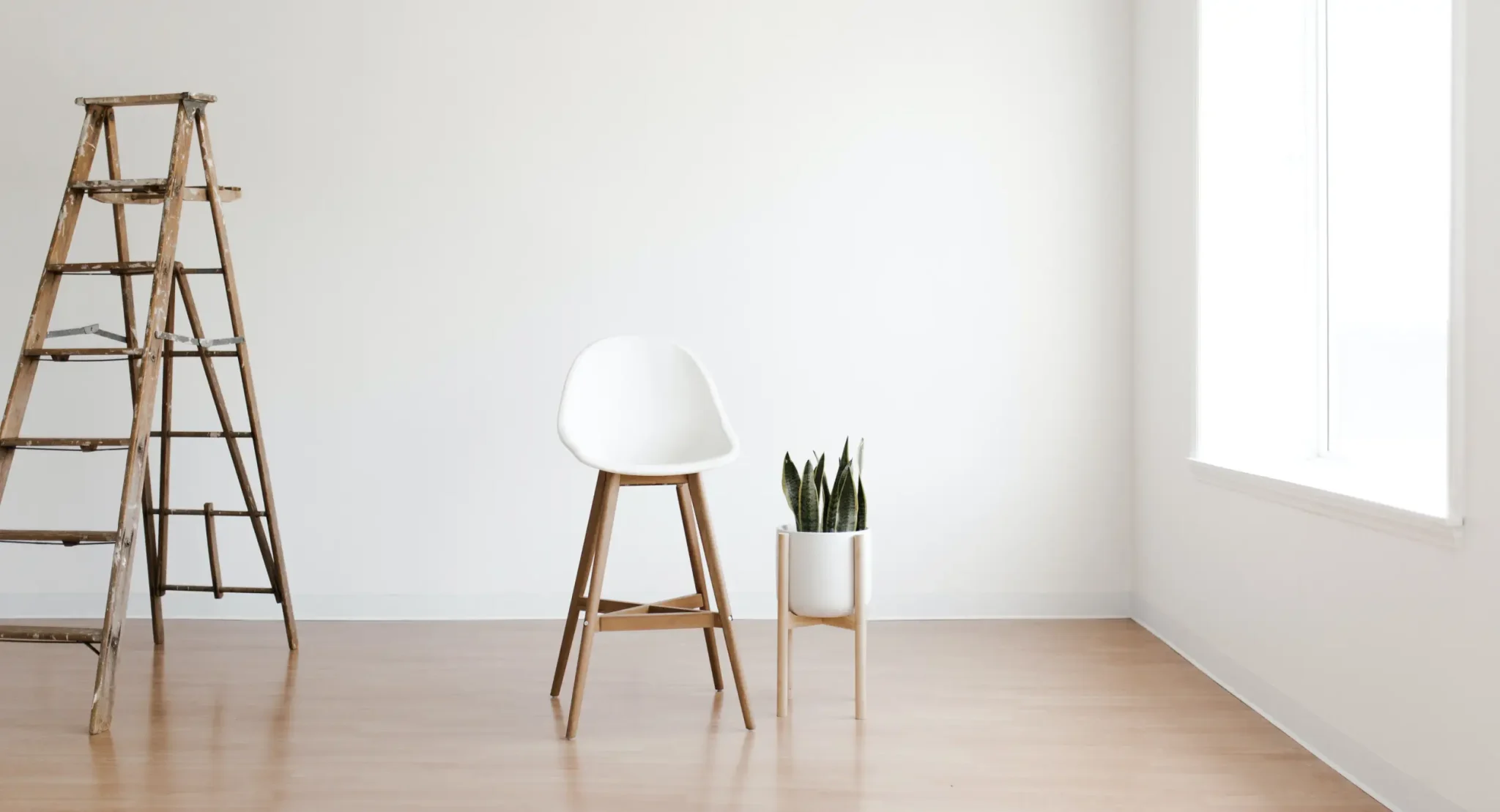Discover a fresh perspective with our image analysis tool
Are you ready to boost your WordPress website‘s visuals? Our image analysis tool provides a comprehensive breakdown of design elements that can inspire your next project. Let’s dive into a remarkable design we analyzed.
Original design overview
The original image features a modern, minimalist layout that communicates themes of growth and technology. It’s a multi-column format that beautifully blends visual and text elements. An image of a ladder and a chair is creatively juxtaposed with a text block that outlines core beliefs.
Detailed breakdown
-
Layout analysis:
The overall structure is a dynamic multi-column format that combines imagery with text. The arrangement includes two distinct columns-one highlights an inspiring image while the other offers informative text.
-
Element and feature description:
The bold header “In a world of technology, people make the difference” immediately grabs attention beneath the main image. A ladder and a chair suggest aspiration, and a portrait introduces a relatable human element. The text block titled “What we believe in” outlines transformative ideas, paired with typography that makes use of bold fonts and clean sans-serif body text.
-
Unique design aspects:
Merging human imagery with structural elements like a ladder symbolises growth and partnership in a tech-driven world. The multi-column layout indicates adaptability, ready for use across devices. High contrast between text and background enhances readability.
-
Overall design style:
The design embraces a modern, minimalist style, focusing on essential elements to avoid clutter. Effective use of visual hierarchy guides the eye while strategic white space improves readability and aesthetics.
Why use our tool?
Our image analysis tool offers valuable insights into effective design practices. Understand how layout, typography, and imagery work together to create stunning content that connects with your audience. Boost your WordPress website design today using powerful design analysis!
Organisational tips for your WordPress site
Categories
Organising your content using categories is an essential way to improve user navigation on your site. Categories allow you to group related posts together, making information easier to find. For instance, a food blog might organise posts into categories such as “Recipes,” “Reviews,” and “Tips.” This not only enhances user experience but also helps search engines understand the structure of your content, which can boost your site’s visibility.
Tags
Tags are a simple yet powerful way to improve content discoverability in WordPress. Unlike categories, tags provide a more specific way to label your content. Use them to highlight key topics and themes within individual posts. For example, a travel blog post might use tags like “backpacking,” “Europe,” and “budget travel.” Well-chosen tags create a nuanced system that helps users find content that matches their interests.
Menus
Using a well-structured navigation menu is crucial for guiding visitors through your WordPress website. A clear and intuitive menu helps users find what they’re looking for quickly and easily. Consider using drop-down menus for subcategories and related links, enhancing the user experience. A thoughtfully designed menu can be the difference between a cluttered, confusing site and an engaging, user-friendly one.
Widgets
Widgets offer a flexible way to add functionality and features to various parts of your site, such as sidebars and footers. Whether displaying recent posts, a search bar, or social media links, widgets play a crucial role in personalising your site and engaging visitors. Make use of these tools to provide quick access to important features and updates without overcrowding your main content areas.
Pages
Pages serve as static content cornerstones for your site, like About Us or Contact pages. Unlike blog posts, which appear in reverse chronological order, pages exist outside the blog timeline. Use them to communicate core information such as your business background, services offered, or contact details. Crafting clear and informative pages helps build credibility and trust with your audience.
Posts
Posts are the heart of dynamic content in WordPress, used primarily for news updates and blog entries. They appear in the blog section in reverse chronological order and are typically tagged, categorised, and archived. Regular posting keeps your site lively and informs search engines that it is active, potentially enhancing SEO rankings.
Custom post types
Custom post types extend WordPress’s capabilities beyond standard pages and posts. They’re perfect for sites needing specific functions, like a portfolio, testimonials, or product listings. Custom post types allow for a highly tailored content organisation that fits the unique needs of your site, providing a versatile way to manage specialised content forms.
Media files
Effective management of media files like images and videos involves naming, categorising, and optimising them for the web. Proper file organisation saves time, aids in faster retrieval, and enhances site performance. Utilise WordPress’s media library for streamlined uploading and tagging, ensuring that your visuals complement the website’s content without slowing down the site.
Comments
Managing comments encourages user interaction and builds a community around your WordPress website. Moderating and approving comments keeps discussions positive and respectful while eliminating spam. Engage with your audience by responding to their feedback and incorporating their suggestions, fostering a connection that is beneficial for long-term site growth.
Plugins
Plugins are tools that expand WordPress’s capabilities, offering a range of features like SEO optimization, social media integration, and enhanced security. They offer customisation without the need for coding skills. Choosing the right plugins enhances site functionality and user experience while maintaining site speed and security-essential in building a robust website ready to meet diverse needs.
Different types of content in WordPress
Blog posts
Blog posts are dynamic pieces of content found on your WordPress site. These entries can be about any topic you choose, whether it’s news updates, personal stories, or specialised subjects. They appear in reverse chronological order and often come with categories and tags that improve organisation. Keeping your blog posts frequent and relevant encourages visitors to return, engaging them with fresh content and contributing to your site’s SEO standing.
Static pages
In contrast to blog posts, static pages in WordPress deliver essential but less frequently updated content such as your homepage, about us, and contact information. These pages provide visitors with crucial details about your site’s purpose and how they can engage more personally with you or your organisation. Static pages don’t follow the typical blog timeline, allowing them to float freely within your site’s navigation.
Portfolios
If you’re a creative professional, adding a portfolio to your WordPress site can effectively showcase your works. Portfolios are custom post types designed to highlight projects and works in a visually appealing manner. They include options to categorise and tag items, making it easier for visitors to browse through your work. An attractive, well-organised portfolio increases your credibility and highlights the range of your skills to potential clients or employers.
Testimonials
Gathering and displaying testimonials on your WordPress site provides social proof of your or your company’s capabilities. These positive endorsements from satisfied clients can be posted on specific pages or in dedicated sections, enhancing trust and credibility. Testimonials can also be styled through various plugins, allowing you to present this user-generated content attractively and effectively engage potential customers.
Galleries
Photo galleries are a staple feature in WordPress, perfect for showcasing images in a structured layout. Whether they appear on a dedicated gallery page or alongside a particular post, galleries visually engage visitors and guide them through your content. Easily created and managed within WordPress, you can also use plugins to extend gallery functionalities, offering slideshows, lightboxes, and more for enhanced user experience.
Events
Using an events custom post type or plugin in WordPress enables you to promote and manage upcoming events on your site. This feature can include event dates, locations, descriptions, and links to tickets. Events featured prominently can drive engagement and attendance, making it easier for site visitors to discover and participate in what your organisation offers, thus enriching their interaction with your site.
Products
For sites run on WordPress with e-commerce in mind, adding products as a specific content type enables efficient sales management. Product pages typically offer detailed descriptions, images, pricing, and purchase options. E-commerce plugins like WooCommerce allow seamless integration of products, inventory management, and checkout processes. This setup transforms your WordPress platform into a full-featured WordPress website builder that drives online sales.
News
News sections within WordPress are ideal for sites wanting to keep their audience informed with the latest updates. Whether you’re a corporate site sharing press releases or a community blog posting current events, news items supplement your regular blog content stream. Stylised news tickers or marquees can help draw attention to the latest updates, ensuring your audience stays informed on the topics that matter.
Podcasts
Podcasts are a unique and engaging content form that can be included in a WordPress setup. By incorporating audio content and supporting written materials or show notes, you expand your site’s accessibility and reach. Plugins facilitate easy podcast integration, offering features such as RSS feeds, episode management, and player widgets, making it straightforward for visitors to engage with your audio content.
Videos
Media-rich content like videos can powerfully enhance user interaction on your WordPress site. Integrate videos into posts or pages for tutorials, testimonials, or company introductions to provide an engaging visual experience for your audience. WordPress offers functionality for embedding, hosting, and displaying videos, ensuring smooth playback on various devices, keeping users engaged longer and encouraging repeat visits.
Conclusion
Investing in the right tools can significantly impact your WordPress website‘s effectiveness, from Elementor Alternatives for versatile layouts to understanding WordPress block themes. By utilising our image analysis tool, you unlock a deeper understanding of design essentials, setting your site apart in the digital realm. Boost your website’s appeal and functionality today with WordPress website design insights and an array of content and organisational strategies.





